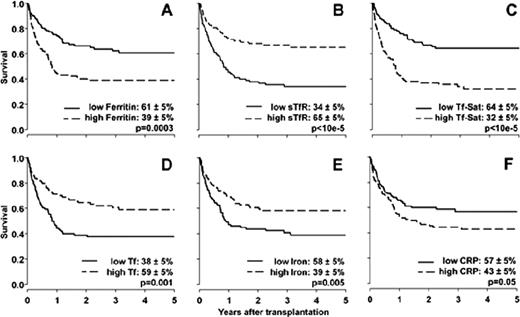Abstract
Abstract 168
Pre-transplant iron overload contributes to increased transplant related mortality after allogeneic hematopoietic stem cell transplantation (HSCT). Serum ferritin is a useful marker to detect iron overload, and is strongly associated with survival rates after allogeneic HSCT. Ferritin is also elevated in patients with inflammatory conditions and may therefore lack specificity as a marker of iron overload. Other iron parameters such as the soluble transferrin receptor (which is not elevated during acute phase reactions), or transferrin saturation (which strongly correlates with non-transferrin bound iron causing tissue damage) might be superior as prognostic parameters.
We retrospectively studied pre-transplant serum iron parameters (ferritin, transferrin, transferrin saturation, iron, soluble transferrin receptor [sTfR]) in 230 consecutive patients undergoing myeloablative allogeneic stem cell transplantation at our centre between 2002 and 2009. C-reactive protein (CRP) was measured as a marker for inflammatory diseases. Median age at transplant was 45 (range 17–70), 132 patients were male, 98 female. Diagnoses were ALL (n=43), AML (n=123), lymphoma (2=37), MPN (n=20), and non-malignant disorders (n=7). Conditioning was with Cy/TBI +/− VP 16 (n=109), BEAM/Fludarabine/TBI (n=29), BuCy (n=88), or other (n=4). All patients received pharmacological GvHD prophylaxis with CSA/MTX (n=201) or CSA/MMF (n=29).
Median values of iron parameters were: ferritin 1342 ng/ml (range 7-7'260); transferrin 1.9 g/l (range 0.8–3.5); transferrin saturation 36% (range 4–106%); iron 18 μ mol/l (range 3–52); sTfR 3.2 mg/l (range 0.3–73). Interestingly, no significant correlation was found between ferritin and CRP (r=0.09, p=0.16). All iron parameters predicted survival, when patients were categorized into those with levels below or above the median. In Kaplan-Meier analysis, transferrin saturation showed the highest predictive power (5 year survival if below median 64±5%; if above median 32±5%; likelihood ratio [LR] 23.2, p<10e5, Figure 1). Ferritin, in comparison, had lower prognostic significance (survival 61±5% versus 39±5%, LR13.1, p=0.0003). The predictive power of sTfR was between that of ferritin and transferrin saturation (34±5% versus 65±5%, LR 20.2, p<10e5), whereas transferrin and iron fared markedly worse and were not further analyzed. In multivariate Cox models adjusted for diagnosis, disease stage, CRP, stem cell source, donor type, and year of transplant, hazard ratios with borderline significance were found for ferritin (HR 1.51, 95% CI 0.98–2.33, p=0.06) and sTfR (HR 1.50, 95% CI 0.96–2.34, p=0.07). In contrast, transferrin saturation retained clear prognostic significance (HR 1.90, 95% CI 1.23–2.94, p=0.004). Receiver operating characteristic curve analysis confirmed the superiority of transferrin saturation as a predictor of transplant outcome over a wide range of cutoff values (area under the curve for transferrin saturation 0.715, for ferritin 0.657, Figure 2).
Iron overload strongly influences outcome of allogeneic stem cell transplantation. In this population of patients with a history of repeated red blood cell transfusions, serum ferritin levels were not significantly influenced by inflammatory states, as assessed by the lack of association with elevated CRP levels. Of the iron parameters studied, serum transferrin saturation had the highest predictive power in both univariate and multivariate models.
Kaplan-Meier estimates of survival after allogeneic HSCT in patients stratified according to below- or above-median pre-transplant iron parameters and C-reactive protein
Kaplan-Meier estimates of survival after allogeneic HSCT in patients stratified according to below- or above-median pre-transplant iron parameters and C-reactive protein
Receiver operating characteristics (ROC) curve for pretransplant ferritin, soluble transferrin receptor, and transferrin saturation levels as predictors for 5-year overall survival
Receiver operating characteristics (ROC) curve for pretransplant ferritin, soluble transferrin receptor, and transferrin saturation levels as predictors for 5-year overall survival
No relevant conflicts of interest to declare.

This icon denotes a clinically relevant abstract
Author notes
Asterisk with author names denotes non-ASH members.



This feature is available to Subscribers Only
Sign In or Create an Account Close Modal